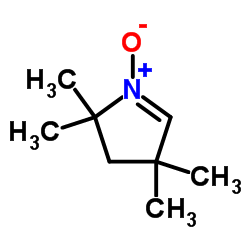Real-time continuous-flow spin trapping of hydroxyl free radical in the ischemic and post-ischemic myocardium.
S Pietri, M Culcasi, P J Cozzone
Index: Eur. J. Biochem. 186(1-2) , 163-73, (1989)
Full Text: HTML
Abstract
Real-time monitoring of spin-trapped oxygen-derived free radicals released by the isolated ischemic and reperfused rat heart has been achieved by ESR analysis of the coronary effluents using continuous flow detection and high-speed acquisition techniques. Two nitrone spin traps 5,5-dimethyl pyrroline 1-oxide (Me2PnO) and 3,3,5,5-tetramethyl pyrroline 1-oxide (MePnO) have been separately perfused at a concentration of 40 mM during a sequence of 50 min of low-flow ischemia (1 ml/min) followed by 30 min of global ischemia and subsequent reperfusion at the control flow rate (14 ml/min). ESR spectra were sequentially obtained in 5-min or 30-s blocks during low-flow ischemia and reperfusion, respectively. 1. The results show the formation of OH. free radicals in the ischemic and reperfused heart, as demonstrated by the observation of Me2PnO-OH (aN = aH = 14.9 G; g = 2.0053) and Me4PnO-OH (aN = 15.2 G, aH = 16.8 G; g = 2.0055) spin adducts. There is no evidence of significant biological carbon-centered or peroxyl free radicals spin-adduct formation in the coronary effluents or in lipid extracts analyzed after reflow. 2. The OH. generation began 15-20 min after the onset of ischemia and was moderate, peaking at 30-40 min. During reperfusion, an intense formation of OH. spin adducts was observed, with a maximum at 30-60 s and a further gradual decrease over the following 2 min. 3. Cumulative integrated values of the amount of spin adducts released during the ischemic period show a Me2PnO-OH level fourfold greater than that of Me4PnO-OH. It was 2.5 times greater during reflow, reflecting slower kinetics with the more stable Me4PnO. 4. The original ESR detection technique developed in this study allows accurate real-time quantitative monitoring of the oxygen-derived free radicals generated during myocardial injury. It might provide a quick and reliable new means for assessing the efficacy of free-radical inhibitors.
Related Compounds
| Structure | Name/CAS No. | Molecular Formula | Articles |
|---|---|---|---|
 |
3,3,5,5-tetramethyl-1-pyrroline n-oxide
CAS:10135-38-3 |
C8H15NO |
|
Use of 3,3,5,5-tetramethyl-1-pyrroline-1-oxide spin trap for...
1989-11-15 [Biochem. Biophys. Res. Commun. 164(3) , 1274-80, (1989)] |
|
The effect of myoglobin on the stability of the hydroxyl-rad...
1994-05-01 [Free Radic. Res. 20(5) , 327-32, (1994)] |
|
Oxidation of spin-traps by chlorine dioxide (ClO2) radical i...
1996-01-01 [Free Radic. Biol. Med. 20(6) , 837-41, (1996)] |
|
Spectral editing based on selective excitation and Lee-Goldb...
2006-06-01 [Solid State Nucl. Magn. Reson. 29(4) , 272-7, (2006)] |
|
Use of M4PO and oxygen-17 in the study on hydroxyl radical g...
1994-03-01 [Biochem. Mol. Biol. Int. 32(3) , 523-9, (1994)] |